.
In the beginning, we can imagine a Mars somewhat like early Earth.
A world with a thick reducing atmosphere, an active surface, high temperatures
produced by greenhouse effects, and perhaps free water. Martian
water during this phase would have tended to collect at the poles, and
there may have been small polar caps during this period.
Mars seems to have possessed a hot rotating core during this period, and
a planetary magnetic field.
The planet was probably cooling during this time. The crust had
formed, and seemed to be stable. There was nothing like terrestrial
plate tectonics at work, which suggests either that the planet had cooled
to the point where it simply wasn’t going to happen, or that the crust,
like Venus’ was particularly thick.
Did life develop during this early period? Were conditions
for life even possible? We probably may never know, except
by going there. But one thing was for sure.
Things were about to get a lot more interesting.
Mars history appears to have been shaped by two immense asteroid impacts
perhaps three to four billion years ago, during the early formation of
the planet.
The Argyre Impact
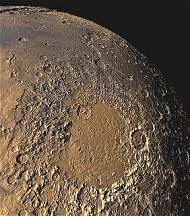

The first of these was probably Argyre, located in the southern Hemisphere.
To give you an idea of just how huge an impact Argyre was, its worth noting
that we’ve never found anything comparable to this on any of the inner
planets.
The largest known craters on the Moon are about one hundredth the size
of Argyre. It’s possible that the moon received Argyre
sized impacts so violent that they actually melted part of the surface
and created a lunar Maria rather than a crater. But this is not verified.
Nothing close to as a catastrophic as Argyre appears on either Venus or
Mercury.
The Argyre impact left a crater roughly eleven hundred of miles in diameter,
almost four miles deep and as almost a million square miles of area, and
was so ferocious that the shockwave actually shook the entire planet, running
completely through the planet’s core and crust, and discharging its energy
on the opposite side of the planet, much like one of those ‘kinetic ball’
toys that litter executives desks.
The result was a small upwelling in the area in the northern hemisphere
now called Elysium, and a complex of at least three volcanoes, including
Elysium Montes, Albor Tholus and Hecates Tholus.
Meanwhile the Argyre impact deformed the surface where it hit, creating
an immense depression, the crater, and pushing up the land around it into
a series of rings of mountains.
There was more. The Argyre impact must have blown away a
chunk of the atmosphere, the impact of the body hitting the atmosphere
accelerating some Martian air into escape velocity. The impact
also kicked up hundreds of thousands, even millions of tons of debris.
Some of it immediately fell back as a huge splash of debris, dozens, even
hundreds of feet thick. This was thickest immediately around
the impact area, and tended to thin out the further away you got.
But instead of being a fully round bloom, the debris field was distorted.
The hit was low in the southern hemisphere, not too far from Mars axis
of rotation. The swiftly rotating planet was moving as the debris
fell, thus the debris pattern seemed to spread out and thin out towards
the equator, as well as concentrate and thicken towards and at the pole.
The phenomena is easy to grasp. Imagine that the debris
field is spreading out uniformly in a circle. Now, the planet
is rotating once every 24 hours. The equator is moving fastest
in relation to the falling debris. The south pole is not moving
at all. As the debris falls north towards the equator, the
equator is turning. Thus debris which falls immediately, falls
in a different spot than the debris which falls a few minutes later, or
a few hours later. The result is that the debris field starts to
‘stretch out’ towards the equator. Meanwhile, the pole isn’t
really moving at all. Debris which falls a minute or an hour
later towards the pole is still falling into the same general location.
So the result is a build up at the south pole, and a distorted smearing
towards the equator.
Now, this means the south pole is covered thick with debris.
We don’t know whether or not there was an ice cap during this era of Martian
history, but its quite possible that there was. Any small ice cap
at the southern pole would have been permanently buried, by a wave of rock
and dust hundreds of feet thick, compressing into a hard rock shell.
Some debris made it into the upper atmosphere, even as high as low orbit,
perhaps circling the planet a few times before falling to the surface.
Again, this concentrated in the southern hemisphere, but tended to spread
more evenly. Some of the debris of impact may have even
reached escape velocity, becoming spaceborn.
But that was just the warm up act. Hellas was coming.
The Hellas Impact
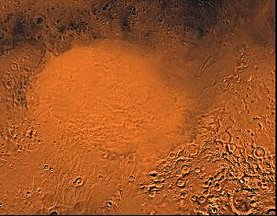
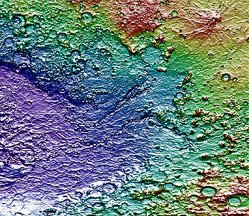
I’ve talked about just how colossal an impact Argyre was. But compared
to Hellas, Argyre was almost walk in the park. This was
a planet buster. To give you some idea of scale, Hellas
impact basin is about 1430 miles across, it was a dent in the planet six
miles deep, with an area of approximately million, six hundred thousand
square miles. The primary ring of impact debris is almost 2500
miles across, and rises up to a mile and a half above the planetary mean
(a sort of sea level). It is the largest impact known of in
the Solar System.
Only on a few smaller bodies, Jovian satellites, do we see impacts of
this magnitude. Literally, Hellas was close to as big an impact
that a planet like Mars or Earth could sustain and not actually break apart.
The energy released by Hellas, equivalent to millions of hydrogen bombs,
would have been sufficient to incinerate all life on the planet, if any
existed then.
So what happened? The same thing as Argyre, only bigger.
The impact created an immense round depression, a dimple or divot in the
lower hemisphere. The surrounding crust was distorted and displaced,
pushed up all around the impact site in a broad circular highland.
In fact, it may well have distorted the shape of the entire planet, creating
lowlands in the northern hemisphere, leaving a slightly ly pear shaped
planet.
Once again, millions of tons of rock and debris were kicked up.
According to some estimates, if all of the Hellas debris fell on an area
the size of the continental united states, it would have formed a blanket
of rock two miles thick. The result was a huge rather distorted
looking ring.
Some of it fell back immediately in the same pattern as Argyre.
A kind of smear, concentrating thickly at the pole, stretching out towards
the equator. Argyre, caught in the debris field, was partially
covered with debris, making it comparatively shallower. In
fact, Argyre’s relative shallowness and lack of contrast, compared to Hellas,
is our tip that the Argyre impact probably came first.
The size of the impact was much more massive, so some of the debris
even crossed the equator, where the planet’s rotation tended to smear it
closest to the equator and concentrate it in higher latitudes.
This became the area known as the Syrtis Highlands of the northern Hemisphere.
Of course, orbital drift would leave it fairly wide towards the equator,
with a pronounced drift or gradual slope in one direction. As you
went higher, the debris would tend to concentrate, the debris growing narrower,
and the leading edge starting to bend in a sort of hook shape.
Of course, debris, because of rotation, would have tended to accumulate
at the planetary poles. The result, in the south pole, was
another layer of debris and a remarkable bulge, which sat upon the debris
resulting from Argyre. If there was a southern ice cap, it
was now definitely buried. Mars may well have a ‘fossil’ Ice Cap
buried at the South Pole, with water billions of years old, preserving
a record of the early atmosphere and chemical composition of Mars.
But Hellas also produced another bulge from collecting debris at the
north pole, less impressive, but nevertheless, an odd bulge.
Again, this may leave us with a ‘fossil’ polar ice cap, though arguably,
the debris layer was much less thick. The frozen water here
may well have been more accessible to the surface and melted or partially
melted away at some point, leaving odd caverns, and perhaps a collapsed
landscape.
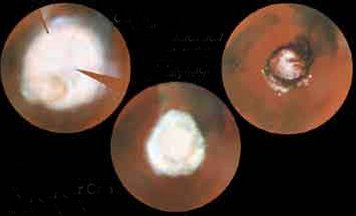
Mars North Polar Ice Changing with the Seasons
By the way, just to be fair, I’m not aware of any scientists who argue
that there may be ‘fossil’ ice caps of primeval Martian water buried at
the poles. This is just speculation on my part, in part because
it dovetails with Burroughs Mars, but also because I think it makes sense
in terms of the Martian history I am trying to reconstruct.
Actual photographs of the poles show mixed layers of light and dark
material, ice and debris, carved into a spiral pattern (consistent with
rotation on axis during debris fall. The South Pole is more heavily
mixed than the north pole, so I might well be onto something here.
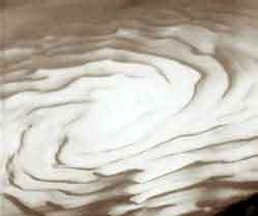
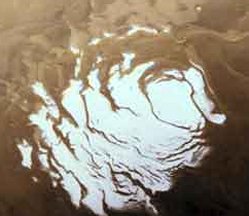
Mars North Pole
~ Mars South
Pole
More debris reached the upper atmosphere or orbital reaches, even orbiting
Mars before falling back to the ground. This debris covered
much of the southern hemisphere, but inevitably spread into the north,
carpeting Mars with a layer of dust, gravel and rock.
Some of it, of course, managed to reach escape velocity, becoming meteorites.
And of course, once again, the impact must have blown a chunk of Martian
atmosphere out into space. This did not, however, leave us
with the wafer thin atmosphere of the present day, or at least, not right
away. Things are still interesting, as we’ll see later.
There’s a couple of final effects of Hellas that have to be accounted
for. Like Argyre, the shockwave travelled through the core
and around the crust, concentrating on the opposite side of the planet.
For Argyre, this had resulted in a small lifted area and a handful of volcanoes.
For Hellas, the result was the Tharsis bulge, a massive area of uplift
the size of a small continent, the highest spot on the planet.
And the result was a series of volcanoes on Tharsis, including Olympus
Montes, at 16 miles high and four hundred square miles, the largest mountain
in the solar system. Joining nix Olympica were a row of three volcanoes
known as Tharsis Montes (individually, Arsia, Pavonis and Ascraeus Mons),
as well as Tharsis Tholus and Alba Patera.
But even that did not account for the massive energies discharging from
the opposite side of the world from the Hellas impact. The
titanic blast, or perhaps the resulting uplift of the Tharsis region literally
caused a tear in the crust, a three thousand mile rip, up to ten miles
deep in spots, that we’ve named Valles Marinis. The scope of
this feature is simply unique in the solar system. There’s
nothing like it that we know of anywhere else in the inner solar system,
or in the giant moons of the outer system. There may have been a
similar tear on Tharsis itself, but this, in a far more active area, produced
an upwelling, leaving a long, curving, rugged ridge near the equator.
And that should be it for Mars, you might think. A couple
of savage planet shaping impacts and there you go. The Volcanoes
will sputter and belch for a while, but that should be about it.
If there was an atmosphere, then the impacts should have blown it off,
if there was water it was vapourized, if there was life, it was incinerated.
But that’s not the end of the story at all. Nope, interesting
things were still happening on Mars, believe it or not.
A Divided World

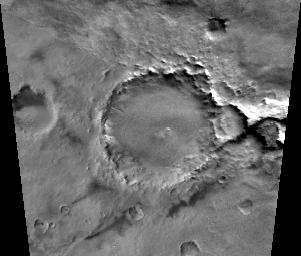
Olympus Mons ~
Burroughs Crater
In the 1960's, Earth sent its first space probes, the Pioneers, towards
Mars. These would be the first close up pictures received for
any alien world, apart from the Moon. To the dismay of romantics,
the pictures revealed a heavily cratered surface, far closer to the Moon’s
scarred visage than anything we imagined. Mars, it seemed,
was just a dry and dusty cratered ball. No lost cities, no
waters or seas, no belts of greenery, no canals or channels.


Pioneer Probe ~
Viking Probe
In fact, the Pioneers were only getting pictures of the southern hemisphere.
In the 1970's, with the Viking Probes, we began to get pictures of the
northern hemisphere.... And things got strange.
Because the northern hemisphere had barely any craters at all.
We were looking at two different planets. A south which resembled
the moon, and an oddly smooth and featureless north.
To make matters even more complicated, the north was actually at a lower
average elevation than the south. The south was, on average,
kilometers higher than the north.
Now this was a puzzle. In fact, the craters made sense.
The Moon, Mercury and even Venus were all heavily cratered.
Earth, because of the continuing sublimation of its surface through plate
tectonics, and because of water and wind erosion, shows very few craters.
It shouldn’t have been surprising that Mars had lots of craters, and it
wasn’t.
Current cosmological theory, by the way, now holds that the major waves
of meteor impacts and the major period of crater formation for the Moon
and inner world was probably around 3.2 billion years ago.
This gives us another clue as to the antiquity of the Hellas and Argyre
impacts, which obviously must have taken place during or before the crater
formation period. (Although its possible that some of Mars cratering
may have been the debris falling back from the impacts.) Argyre
is believed to be 3.9 billion years old.
But still, this weirdly lopsided planet posed a problem.
There were smooth lowlands and cratered highlands. How does
that happen? Normally, one assumes that the higher areas have
been built up over a longer period and are more geologically active.
The Lunar Maria, are large smooth areas because they were geologically
more active, their rocks are younger, and thus, less time and less opportunity
for cratering.
This means that the highlands should be geologically younger than the
lowlands. So, under normal reasoning, one would expect severely
cratered lowlands and smooth highlands. The opposite of what
we were getting. Perhaps some force removed a few kilometers
of the planet’s surface in the northern hemisphere, leaving a smooth area?
But there was no good explanation for how that could happen, or why those
forces would be so comparatively neat in doing one side of the planet,
and not the other.
It was only after we began to assemble detailed topographies in the
90's, that the processes created by Hellas and Argyre became clear.
We know now why Mars has its highlands and lowlands, and why they are shaped
the way they are. But that still didn’t answer the puzzle.
Why were the lowlands so smooth?
The Great Polar Ocean
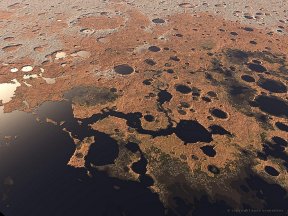
The topic is still raging, but to my mind, there is only one reasonable
explanation: Water. Since the 1980's, there
has been speculation that Mars had an ocean filling much of its northern
hemisphere, divided into three great lobes by land masses stretching up
from the equator, including the Tharsis Bulge, the Syrtis highland and
the Elysium plateau, and covering as much as a third of the planet.
Water processes eroded the north hemisphere craters. Ocean
currents filled them with silt. Sedimentation buried features.
Lesser seas filled the Hellas and Argyre plateaus.
Ironically, we have returned full circle to the Astronomers of the 1890's
with their belief in a vanished Martian ocean. However, those
astronomers located their ocean in the dark central and lower areas, and
considered the light northern area to be a weathered desert continental
region. We now know that the dark central areas are mostly highlands,
and the apparent continent is actually the lowland, the site of our hypothetical
ocean.
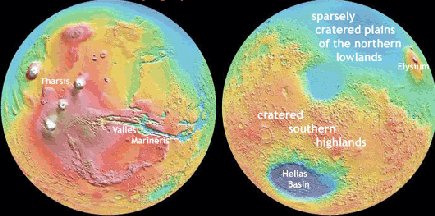
Now, the timing is critical here. Obviously, the Ocean,
if it existed at all, must have existed after the meteor bombardments that
made the southern hemisphere so moonlike. If it was gone by
then, then obviously, the northern hemisphere would have ended up looking
just like the south’s moonscapes. So, it either developed afterwards,
or was there before and after. Either way, the period of the
Ocean must be much closer to us than the period of the bombardment.
Where did this Ocean come from? That’s not clear.
It may have always been present, and Mars could have been a very wet world
before Argyre and Hellas. Considering how immense those impacts
were, then Mars must have been literally buried beneath waters, for an
ocean to actually survive and reform.

North
Pole Shorelines
Or it may be that the Ocean may have actually been formed by cometary
water, so that its period of development may have been during the bombardment.
In which case, the early age of Mars, some three billion years ago must
have been a very exciting place indeed. Impacting comets and
meteors blasting huge craters, water vapours from the impacts filling the
atmospheres, melting or melted balls of comet ice flowing in rivers across
the surfaces, forming the southern seas and the northern ocean even as
Volcanoes sputtered and belched. If, in fact, the water,
or part of the water was cometary, then we should see channels and flow
areas in the highlands, marking the pathways of water as it made its way
to the Ocean and the southern Seas. If this is how it
happened, it must have been a savage, exciting, world, full of possibilities,
including even the possibilities of life.
Of course the huge question is how much water there was, and how long
it lasted. Here, opinions are split. The consensus
is now that Mars must have had surface water at one point. The evidence
of rivers pathways, of sediment deposits, of water erosion is unmistakeable.
Water is clearly present at the poles in the ice caps.
But what was it like? Were the rivers of Mars fast flowing
affairs, sudden floods, boiling away in a too thin atmosphere even as they
ran. Was Mars water only a brief affair, perhaps a matter of
years or millenia. In this view, the wet period of Mars was
frenzied and brief, evaporating away almost immediately.
At the other end of the debate, are those who argue for and speculate
upon a Martian Ocean, an immense body of water that may have endured for
hundreds of millions or even billions of years. Existing, perhaps
two billion years ago or less. It is one of those debates that cannot
be conclusively answered without someday going there and poking around
in person.
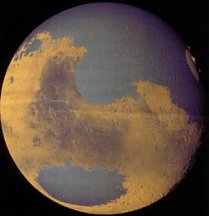
Mars
Oceans (NASA Art)
But over time, the indications seem to be inclining steadily towards
the ‘long wet’ proponents. The evidence for water, and particularly,
the evidence for lots of water just keeps getting better and better.
Analysis of the atmosphere, spectrographic readings of the surface and
evaluation of the soil and surface by probes seems to provide mounting
evidence for a lot of water, and for water lasting a lot longer than we
previously believed. Among the remarkable discoveries are calculations
based on the atmosphere composition that the planet may have had enough
water to, at a minimum, cover its entire surface fifty feet deep.
There is evidence of a frozen sea buried beneath the surface of thousands
of square miles area. There is a quick observation of something
that might have been a geyser. There is evidence of a lot of
water at the poles, and not just frozen carbon dioxide, and evidence of
frozen water under the surface in permafrost.
Some researchers estimate that Mars at one time may have had enough
water to cover the entire planet to a depth of a mile. Even now,
some researchers estimate that there may still be enough water at the poles
and buried under the surface to cover the planet to a depth of 20 meters
or more.
So, was there an ocean? Seas? The debate rages
on. Nevertheless, it is a romantic thought, and we can’t really
know for sure, but the evidence allows us to at least entertain the possibility.
For the record, I can admit to stretching things for the romantic side,
to opt for a warm ocean world.
But there is more. The presence of surface water for any
length of time, or the presence of an Ocean for a protracted period of
time, suggests that the atmosphere must have been denser. As
dense as Earth’s atmosphere currently, as much as 100 or 150 times denser
than it is on Mars now. (The Martian atmosphere is currently seven
tenths of one per cent of the thickness of terrestrial atmosphere at sea
level).
A dense atmosphere, if it existed, would have produced a greenhouse
effect, leaving Mars a far warmer world than it is now. Of
course, warm is a relative concept, and does not necessarily give us a
tropical Mars. Today’s Mars gets very very cold, the mean temperature
is minus 63 celsius, with highs of twenty degrees and lows go down to minus
130 degrees. Living in northern Manitoba where we occasionally
approach minus 40 or 50 below, that’s spectacularly appalling.
A warm Mars may have merely had polar or sub-polar temperatures.
Whatever Happened to Young Mars
So what happened to the warm Mars? Where did all that water
and atmosphere go. Undoubtedly, some of it boiled off into
space over millions and billions of years. Mars gravity is only 38%
of Earth’s, and Earth continually loses bits and pieces of its atmosphere.
So if Earth’s atmosphere is normal for its gravity, then Mars would have
real problems hanging onto what it had.
But is Earth’s atmosphere normal for its gravity. Venus
is slightly smaller than Earth, with perhaps 85 to 90% of terrestrial gravity,
and yet, its atmospheric envelope is far denser than Earth’s.
At its surface, air pressure is ninety times Earth’s. And Venus
is far closer to the sun and far hotter than our world, so its losses from
heating and solar wind must be greater. So, the bottom line
is that with only three planets to work with, we have too much range and
few too samples to really know what is or isn’t typical, or whether a thick
atmosphere on Mars really is or isn’t sustainable. So, while
Mars lower gravity may be a culprit, we really can’t know.
It is entirely possible that gravity isn’t the story at all, or its not
the beginning or end of the story. Likely, it is part of the
story, but equally likely, not the whole.
Mars magnetic field is now dead, although there are weak ‘fossil’ magnetic
fields all over the planet, leftovers of the days when the planet’s core
was turning like a dynamo. Some of these ‘fossil’ magnetic
fields extend well beyond the planet’s atmosphere. Earth’s
magnetic field protects us from the charged particles, the higher radiations
of the sun. These charged particles would otherwise sterilize life
and split the molecules of the atmosphere, liberating the hydrogen and
oxygen of water. Hydrogen would quickly escape in the lighter gravity.
Was this the fate of Mars? Its oceans stolen, its atmosphere
thinned, not just by gravity, but by uninterrupted solar radiation?
Possibly, though its worth noting that Venus, as super hot and baked dry
as it is, still has a massive atmosphere, despite it too lacking a magnetic
field. On the other hand, Venus has little or no apparent water
or hydrogen at all. Once again, we’ve got too much range and
too few samples to really come to a conclusion. At best, we can speculate
that the dead magnetic field and solar radiation was a part of it.
One thing which definitely appears to have happened, is that a lot of
atmosphere seems to have gotten locked up in the planet’s surface simply
through geological processes. The Viking Probe discovered astonishing
quantities of carbon dioxide and very strange chemistries in Martian soil.
The red colour of the world comes in large part from massive quantities
of oxygen trapped in the rocks, along with carbon and other elements.
Oxygen, Carbon and even Hydrogen atoms are inherently unstable, they bond
easily with each other and other substances to form complex molecules.
So simple chemistry, particularly ocean and water chemistry, might well
have conspired to lock away a large part of the Martian atmosphere.
And of course, it is known that at least some of that atmosphere simply
froze out at the poles, becoming frozen carbon dioxide. How
much is locked away up there, we do not know.
Some enterprising science writers have suggested that Mars might live
again. Simply drop a few nuclear weapons at the poles, and
liberate all that frozen carbon dioxide and water. The atmosphere
becomes thicker and moister, and the greenhouse effect kicks in, warming
the planet up. The hotter temperatures liberate gases in the
soil, and or makes it easier to liberate, and voila, a nice habitable planet
in only a few decades or centuries. Of course, I suspect that
if terraforming Mars is possible, it would take more than a few hydrogen
bombs lobbed at the poles. But it makes a nice fantasy.
 One quite interesting theory notes that Mars particular mixture of atmospheric
gases seems to be chemically stable at very low pressures, that is, approximately
the pressure of Mars current atmosphere. At higher pressures,
the atmosphere isn’t stable and tends to chemical reactions and reduction.
So, it appears almost that Mars current atmosphere sits in a plateau or
island of stability.
One quite interesting theory notes that Mars particular mixture of atmospheric
gases seems to be chemically stable at very low pressures, that is, approximately
the pressure of Mars current atmosphere. At higher pressures,
the atmosphere isn’t stable and tends to chemical reactions and reduction.
So, it appears almost that Mars current atmosphere sits in a plateau or
island of stability.
The implications of this are simultaneously encouraging and depressing.
What this seems to suggest, is that planetary atmospheres may have ‘islands
of stability’, densities at which a particular mix of atmosphere works
best, and which seem to be self perpetuating. So, an atmosphere
in an island of stability may actually be stable for a very long time,
but once it falls out of that island of stability, it becomes very unstable,
rapidly deteriorating until the next island of stability at a lower pressure.
If this is correct, and frankly, I’m just pissing in the wind here,
then its possible that Mars thick air/wet surface period might have been
very stable and might well have lasted a very very long time.
Which suggests that the dessication and thinning of the world, once some
threshold point, was very rapid. Mars went into free fall,
or free falls, until reaching the current plateau.
The bad news here is that if this is correct, then it is going to be
very very very hard to find a way to push the Martian atmosphere back up
to something Earthlike. There will be very little opportunity
for gradually building the atmosphere will have an innate tendency to return
to its ‘island of stability’. Of course, we have no idea what
the time frames are, so if this process of stabilization takes millenia,
and we can rebuild the Martian atmosphere in centuries, we might get away
with it.
Mars still holds surprises. The most recent news is that
geologists are finding signs of different kinds of rock on Mars.
The theory was that it was all volcanic basalts from a single formation.
Earth’s diversity of rocks from basalts to granites comes from plate tectonics,
the fact that our rocks are continually being subsumed, remelted, and spit
up, refining them. The idea was that Mars, lacking plate tectonics
would not continually subsume and refine its rocks, so all you’d bet would
be basalts, like Venus. Now they’re finding pockets of granite
and other materials. Where does this come from? Perhaps
the volcanism is a little freakier than we’ve thought. Perhaps the
Hellas and Argyre impacts or smaller meteor impacts took the place of tectonic
subduction, producing limited quantities of higher ‘refried’ rocks.
On to Barsoom!
So, having pored over the Mars that Burroughs knew, and the Mars we
know now, are we prepared to investigate Barsoom.
Join me in the other Matching Mars discussions, wherein we locate the
vanished seas of Torquas and Throxeus, chart the Artolian hills, pinpoint
Gathol, explain Omean, reveal the Carrion Caves, map the Toonolian marshes,
identify the lost sea of Korus, discover the mountains of Torquas and find
the forests of Kaol and Onvak, matching these regions to the actual geography
of Mars. And from there, once we’ve got the geography linked, we can then
locate the cities and states of John Carter’s Barsoom on the template of
the real Mars, making

Burroughs Crater on Mars ~ 72.5S 243.1W
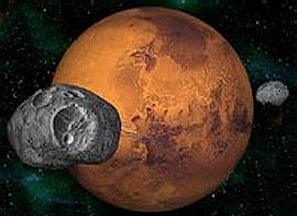
![]()

![]()